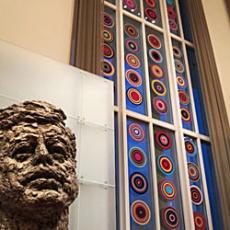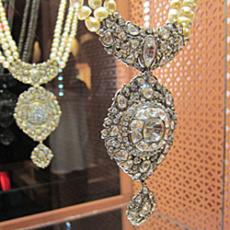
STEVE EMBER: I'm Steve Ember.
SHIRLEY GRIFFITH: And I'm Shirley Griffith with EXPLORATIONS in VOA Special English. Today we travel to India by way of the John F. Kennedy Center for the Performing Arts in Washington, DC. This cultural organization is currently holding a three-week festival that celebrates the art, culture, food and people of India. Join us as we explore the sights and sounds of "maximum INDIA."
(MUSIC: "Mysore Se Ayee" by Raghu Dixit)
STEVE EMBER: That was a song performed by the Indian folk rock musician Raghu Dixit. He is one of many musicians who have performed at the Kennedy Center during "maximum INDIA." Other musicians include the rock band Parikrama the violinist L. Subramaniam, and the opera singer Anando Mukerjee.
SHIRLEY GRIFFITH: Festival organizer Alicia Adams has been working on this event for several years. She visited India many times to put together the festival. She visited dancers, artists' work shops, festivals and restaurants. Then she and other festival organizers decided what they would bring to the Kennedy Center for this event.
Ms. Adams says the name of the festival was influenced by the book "Maximum City: Bombay Lost and Found" by Suketu Mehta. She says the festival's use of the word "maximum" describes India well. Ms. Adams notes that everything in India is "maximum" -- from its colors and environment, to the density and number of its people.
STEVE EMBER: The "maximum INDIA" festival gives visitors to the Kennedy Center a taste of India's many cultures and traditions. India has more than a billion people, 15 official languages, more than 1,000 dialects and more than 300,000 gods and goddesses.
The event has been extremely popular. Almost all of the performances have sold out. Ms. Adams says that many of the free performances have been extremely crowded. The Kennedy Center had to bring in additional sound and screen devices to make room for the huge numbers of people.
Here is U. Shrinivas, a skilled musician in Indian classical music who plays the mandolin.
(MUSIC: "From Folktales" by U. Shrinivas)
SHIRLEY GRIFFITH: In addition to music, "maximum INDIA" offers many kinds of dance and theater performances. Tansuree Shankar is a dancer and dance creator whose company performs Indian modern dance. Other groups performed traditional dances such as bharatanatyam, sapera, and kuchipudi.
The Manipur Chorus Repertory Theatre performed Norwegian playwright Henrik Ibsen's play, "When We Dead Awaken," in the language of Manipuri.
STEVE EMBER: The Ishara Puppet Theatre Trust was one of many shows aimed at younger audiences. The group performed a work called "Images of Truth." The performers used puppets and actors to tell the story of Indian political leader and activist Mahatma Gandhi.
Before beginning the show, director Dadi Pudumjee asked the audience to observe a minute of silence to honor the actors and puppet experts in Japan who may have suffered after last week's major earthquake.
SHIRLEY GRIFFITH: Not all "maximum INDIA" events are about dance, music or theater. Experts discussed subjects including India's cities, women in Indian movies and Indian literature.
Comedian Dan Nainan told funny stories about his unusual cultural background.
DAN NAINAN: "My dad is from India and my mom is from Japan. Yes, I'll let that sink in."
(LAUGHTER)
"In fact, my mom is so Japanese that when I was born, I came out cordless."
STEVE EMBER: Susmita Mohanty is a spaceship designer from India who gave a talk called "3011: Spaceship Utopias." She discussed India's space program and the future of spaceship design. She called for governments to use design experts and not just engineers to make spaceships.
SUSMITA MOHANTY: "What I think the problem is is not because we don't have the imagination or the resources or the talent to build better spaceships. I think the problem is that the design approach that most government agencies take is heavily dependent on engineers only."
SHIRLEY GRIFFITH: Several exhibits at "maximum INDIA" show the work of modern Indian artists. Bharti Kher is an artist born in London who currently lives in New Delhi. Her work, "I've Got Eyes at the Back of my Head," is made up of 5,000 large cloth bindis.

They are attached to the windows of one of the Kennedy Center's long hallways. Bindis are small dots traditionally worn by Indian women on their forehead, in between the eyes. Ms. Kher has enlarged them and organized them in colorful rows.
STEVE EMBER: Jitish Kallat's work, "Public Notice 2," recreates a speech given by Mahatma Gandhi in 1930. Gandhi gave the speech before beginning a 24-day march to protest Britain's unfair control of India's salt trade. Gandhi called for the use of non-violent civil disobedience.
The artist has written out the speech using letters made of fiberglass. The letters are in the shape of bones and sit on a series of temporary wall structures. Mr. Kallat says the speech includes several subjects that could help us rethink the deep aggression in the world today.
(MUSIC: "Humse Rootha Na Karo" by Vatsala Mehra)
SHIRLEY GRIFFITH: Other exhibits explore India's rich craft traditions. One exhibit shows the many beautiful kinds of sari clothing that Indian women wear. Another shows a huge collection of fans used to cool off during warm weather.
One large exhibit imaginatively brings together crafts from the 28 states of India. The large room is made to look like a gathering of sellers at a village market. There are large videos on the walls showing the busy streets of India.
There are many bicycles carrying objects that represent a special local tradition. One bicycle has all the materials needed for making and selling chai, or tea. Another bicycle carries the materials and tools for making paan. Paan is made up of small pieces of areca nut and other spices. People chew it to cleanse the tastebuds in the mouth and support fresh breath. Several of the bicycles also show objects used to honor Hindu gods in religious ceremonies.

STEVE EMBER: Another exhibit is filled with priceless treasures. Visitors can see traditional jewelry made by the Gem Palace company in Jaipur. One diamond and pearl wedding set includes a headpiece, earrings and a huge necklace. It took 75 jewelers three years to complete. Another necklace and earring set is also for a bride. It is made of over 80 carats of diamonds and over 60 carats of red stones called rubies.
SHIRLEY GRIFFITH: No festival of Indian culture would be complete without food. Festival organizers brought in the famous Indian cook Hemant Oberoi to create food for the event. Both Kennedy Center restaurants are offering Indian meals from around the continent. Mr. Oberoi had many dried spices shipped to Washington from India. A local Indian restaurant has helped provide the right tools and fresh ingredients. So Mr. Oberoi and his team are making Indian food that tastes as close as possible to the food they make in their country.
STEVE EMBER: We leave you with a song by the artist Panjabi MC. He will perform twice this weekend at "maximum INDIA." He combines traditional Panjabi music with hip-hop to make songs that make you want to get up and dance.
(MUSIC)
SHIRLEY GRIFFITH: This program was written and produced by Dana Demange. I'm Shirley Griffith.
STEVE EMBER: And I'm Steve Ember. You can see pictures of some "maximum INDIA" exhibits on our website, voaspecialenglish.com. You can also find us on Facebook and YouTube at VOA Learning English. Join us again next week for EXPLORATIONS in VOA Special English.
bharatanatyam: a classical Indian dance form originating in Tamil Nadu, India 婆羅多舞
kuchipudi: 庫(kù)契普迪舞
Manipuri: the predominant language and lingua franca in the southeastern Himalayan state of Manipur, in northeastern India 曼尼普爾文
Indian electricity initiative shines new light on farm garbage
12 cultural sites in developing world listed as most threatened
(來(lái)源:VOA 編輯:崔旭燕)
